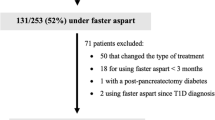Abstract.
The purpose of this study was to determine the feasibility of a flexible multiple daily insulin (FMDI) regimen in routine pediatric diabetes care by comparing HbA1c, body mass index (BMI), and episodes of severe hypoglycemia (SH) before and after initiation of FMDI therapy. Data from 44 patients (2–16 years old), on a conventional insulin (CI) regimen, were collected during quarterly diabetes clinic visits. These patients were transitioned from CI to FMDI regimen: pre-meal lispro (bolus) and once or twice daily Humulin Ultralente with or without bedtime Humulin NPH as the basal insulin. There was a significant improvement in HbA1c in prepubertal (9.3%±1.3% vs. 8.0%±1.1%, p<0.002) and pubertal subjects (9.2%±1.0% vs. 8.2%±0.9%, p<0.001). Pubertal subgroup demonstrated an increase in BMI (21.3±3.1 vs. 22.7±3.2 kg/m2, p<0.0001) after one year. The rate of SH was decreased in both prepubertal (p<0.01) and pubertal (p<0.05) groups of patients on FMDI therapy. The use of FMDI in a general pediatric diabetic population is a feasible therapeutic option for maintenance and possible improvement of glycemic control. It may effectively decrease the HbA1c, and reduce hypoglycemic episodes, without producing an abnormal increase in BMI.
Similar content being viewed by others
Author information
Authors and Affiliations
Rights and permissions
About this article
Cite this article
Alemzadeh, R., Palma-Sisto, P., Parton, E. et al. Beneficial effects of flexible insulin therapy in children and adolescents with type 1 diabetes mellitus. Acta Diabetol 40, 137–142 (2003). https://doi.org/10.1007/s00592-003-0102-2
Received:
Accepted:
Issue Date:
DOI: https://doi.org/10.1007/s00592-003-0102-2




